
| What is Flavor and Fortune? |
| How do I subscribe? |
| How do I get past issues? |
| How do I advertise? |
| How do I contact the editor? |
Read 12879247 times
Connect me to:
| Home |
| Articles |
| Book reviews |
| Letters to the Editor |
| Newmans News and Notes |
| Recipes |
| Restaurant reviews |
| Article Index (all years, slow) |
| List of Article Years |
| Article Index (2025) |
| Article Index (last 2 years) |
| Things others say |
| Related Links |
| Log In... |
| Authors |
| Categories & Topics |
Fruits. Part III: Hawthorn and Beyond
| by Jacqueline M. Newman |
Chinese Food in the Middle East
Spring Volume: 2017 Issue: 24(1) pages: 15 to 19
This series about fruits began in Volume 23-4 and featured apples, apricots, bananas, chayote, cherries, and coconuts. Part II continued with the citrus family and included dates, durian, figs, gingko nuts, goji berries, the gooseberry, grapes, and guavas. Each fruit does include one recipe. In this, the third article, we continue with more fruits common in the Chinese cuisine. In the next issue, information about nuts and berries will follow.
Do note often but not always, one fruit can substitute for another one. A reminder, there are additional fruit recipes in this magazine’s index to be enjoyed by those who prepare them.
 Hawthorn is in the genus
Crataegus, species rhipidophylla.
These local small fruits grow on
shrubs or small trees, and often these have thorny
branches. You may have seen them sold candied and
on sticks in open air markets in early summer. Year
round, they are found dried as wafers sometimes called
haw or flakes. They come wrapped in paper and look
like thin reddish coins. Found in Asian markets, this
fruit is also sold as a drink, in alcoholic beverages, and
preserved or canned. When fresh, they are sweet and
bright red or blackish-brown.
Hawthorn is in the genus
Crataegus, species rhipidophylla.
These local small fruits grow on
shrubs or small trees, and often these have thorny
branches. You may have seen them sold candied and
on sticks in open air markets in early summer. Year
round, they are found dried as wafers sometimes called
haw or flakes. They come wrapped in paper and look
like thin reddish coins. Found in Asian markets, this
fruit is also sold as a drink, in alcoholic beverages, and
preserved or canned. When fresh, they are sweet and
bright red or blackish-brown.
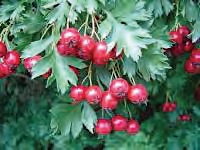
Considered delicacies, they are eaten raw, cooked, and in many other ways. The Chinese call them shan zha; in English they are known as hawthorn or mountain red fruits. Made into assorted snacks with different names, they are very high in vitamin C, have many phytochemicals, tannins, and phenolic acids. TCM or traditional Chinese medical practitioners say they have many uses. These include relieving indigestion, reducing diarrhea and high blood pressure, and removing pain from a hernia when mixed with ground fennel seeds. They also ease the itch of a rash, reduce dizziness and symptoms from dysentery.

| Hawthorn with Pork in Lotus Leaf |
|---|
½ pound pork butt, coarsely chopped 1. Mix pork butt with water chestnut flour and then add
in the minced scallions, both pastes, sesame oil and soy
sauce. Then, add the broken circles of haw, and mix
these well. Put this mixture on the lotus leaves and tie
them into a flat pancake. 2. Now, distribute the cinnamon sticks in various places
on the bottom of a steamer basket and set this tied
pancake on them. 3. Then, add two cups of boiling water into the bottom
of a steamer and steam this on its rack for two hours.
After that, remove it to a pre-heated platter discarding
the cinnamon sticks. Cut the top of the pancake open,
and serve. |
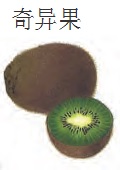 KIWI is a fruit whose botanical
name is Actinidiaceae, and is one
with many species, some say four
hundred or more. Most are called
yang tao, years ago all called Chinese
gooseberries. They are also known
botanically as Souris vegetale, and
were known and eaten by the Chinese
for thousands of years. However,
they were not as popular as they are
today since being called kiwi fruit. Current varieties did
develop from a single seed brought to New Zealand
where they were popularized after their name kiwi was
adopted.
KIWI is a fruit whose botanical
name is Actinidiaceae, and is one
with many species, some say four
hundred or more. Most are called
yang tao, years ago all called Chinese
gooseberries. They are also known
botanically as Souris vegetale, and
were known and eaten by the Chinese
for thousands of years. However,
they were not as popular as they are
today since being called kiwi fruit. Current varieties did
develop from a single seed brought to New Zealand
where they were popularized after their name kiwi was
adopted.
One mature vine can produce some two hundred fruits. They store well in the refrigerator, and can be frozen then defrosted keeping their texture and taste undiminished. Their hairs eventually disappear after they ripen, though few consumers seem to know this; they eat them before fully ripened.
Technically a berry, without fertilization, these fruits grow to be about the size of a hen’s egg.
Their black seeds are edible and not tough. In years past, these fruits were pickled. They were and still are a good source of antioxidants, have many vitamins and minerals, and are a particularly good source of Vitamin C.
TCM practitioners tell us these fruits are good to aid digestion, and can be a heart tonic. Boil their branches and they are used to treat mange in dogs, their vines when young make great rope.
| Shredded Chicken and Kiwi |
|---|
1 whole boneless chicken breast, cut in thin two-inch
strips 1. Toss chicken strips with egg white, cornstarch, rice
wine, and the salt and pepper. 2. Heat wok or fry pan, add oil, and stir-fry chicken strips
until almost crisp then drain and set aside. 3. Add carrots to remaining oil, and when almost soft, add scallions, ginger, garlic, and sugar and stir-fry another minute before adding kiwi pieces, stir for one minute, then serve in a pre-heated bowl. |
 LI ZHI are tree fruits native to
Guangzhou. They are a member of the
soapberry family called Sapindaceae;
its botanical name is Litchi chinensis.
These fruits are very sweet and very
juicy. They have a thin membrane
under their warty exterior skin. Inside
is a hard dark pit, this seed is in its
center. Usually red or pink-skinned
when ripe, these fruits dry out with a
brown crisp outside and are called lizhi nuts.
LI ZHI are tree fruits native to
Guangzhou. They are a member of the
soapberry family called Sapindaceae;
its botanical name is Litchi chinensis.
These fruits are very sweet and very
juicy. They have a thin membrane
under their warty exterior skin. Inside
is a hard dark pit, this seed is in its
center. Usually red or pink-skinned
when ripe, these fruits dry out with a
brown crisp outside and are called lizhi nuts.
This fruits probably went from China to India and then to the US. Their pits can be ground and mixed with fennel and simmered and used to reduce swollen testicles and relieve menstrual pain. Chinese traditional medical practitioners say they are very sweet and improve blood and are good for those who are ill. They are also good for those suffering with asthma, pain from a hernia, and for those with a cold stomach.
Wild li zhi trees grow on China’s Hainan Island and throughout the rest of the country. There are many stories about their love as a delicacy in Imperial courts. In early times, they were described by Michal Boym and others as fruits from trees with thick twigs with smooth internal fruit. Known as far back as 2000 BCE, a famous story is about their use in the courts of Imperial times, rushed at great expense by fast horses to the capital and the court there. Preferred raw, many Chinese purchase them no matter the price when they first come into season. Few cook them or use them in dishes, those that do often use them in a meat dish or a cold soup such as the one that follows.
| Li Zhi, Chayote, and Oyster Soup |
|---|
5 sugared hawthorns on a stick, minced 1. Put peeled li zhi in two cups of boiling water and
set aside, than after half an hour mix them with the
preserved ones on a stick. 2. Put the slivered dried oyster pieces in a quart of
boiling water and simmer them for twenty minutes. 3. Then add the chayote, chicken breasts, and carrot
pieces and simmer for ten minutes, then mash this
mixture gently. 4. Now add two more cups of boiling water, the ginger, black mushroom pieces and the garlic, reduce the heat and simmer for one hour, then stir well, and serve in individual soup bowls. |
 LONGAN, another
ancient Chinese fruit that is
often called dragon eye
fruit, is botanically known
as Dimocarpus longan. They
grow on twenty foot or taller
evergreen trees, and some say
their fruit does look like an
eyeball. We do not see this but
do note they have a dark pit
and white flesh. They are also
known as cassia chief, and in
Chinese are called gui yuan.
LONGAN, another
ancient Chinese fruit that is
often called dragon eye
fruit, is botanically known
as Dimocarpus longan. They
grow on twenty foot or taller
evergreen trees, and some say
their fruit does look like an
eyeball. We do not see this but
do note they have a dark pit
and white flesh. They are also
known as cassia chief, and in
Chinese are called gui yuan.
Not as sweet as the li zhi, they ripen somewhat later. The Chinese consider them warm in nature, and say they benefit the spleen, enrich the blood, increase vigor, calm the nerves, help reduce bleeding, ease pain, and reverse weight loss after illness.
They also say they help settle dizziness and blurred vision. TCM medical practitioners prescribe them to reduce nervousness, reduce heart palpitations, restore weak feelings during pregnancy, and heal ulcers. They also recommend roating their pits and using them for these needs, for scalds, burns, and anemia; and they use their dried skins and pits to make wine. The fruit itself is used fresh and dried when making wines and liquors, and for cooking in many main dishes. They particularly like them in soups and sweet ones.
| Shrimp and Longan Soup |
|---|
½ pound fresh shrimp, peels and veins discarded 1. Soak the peeled shrimp in the wine for half an hour
with the goji berries and dried longans. Then put all of
this in a pot with five cups chicken stock and the hot
pepper slivers. 2. Bring it to just below the boil and simmer for twenty minutes, then add the scallion pieces for five minutes and serve hot or tepid. |
 LOQUAT,
called pi pa
in Chinese, is the same
name as one of their
musical string
instruments. Some
Chinese call these fruits
lu jie or reed oranges,
perhaps because their
fruit is yellow-orange.
They ripen at the end of
summer, and TCM
practitioners say they
cool fevers and increase
saliva, and are good to
relieve constipation in
the aged, and reduce coughs for those of all ages.
LOQUAT,
called pi pa
in Chinese, is the same
name as one of their
musical string
instruments. Some
Chinese call these fruits
lu jie or reed oranges,
perhaps because their
fruit is yellow-orange.
They ripen at the end of
summer, and TCM
practitioners say they
cool fevers and increase
saliva, and are good to
relieve constipation in
the aged, and reduce coughs for those of all ages.
Botanically known as Eriobotrya japonica, these fruits grow on flowering evergreen shrubs or trees, and are in the Rosaceae family. Their origins are quite ancient, and some say they originally came from Japan while most believe they originated in China. There are several varieties and they differ in flavor and color, all with dark green leathery leaves.
The fruits are succulent, smell sweet, grow in clusters, and can have one or many pits. Some have a bitter flavor. Many Chinese tell us they taste like a mixture of peach, mango, and citrus. They were mentioned in ancient Chinese literature, sometimes as lu jie. Some of the fruits have light hair on their exteriors.
Chinese TCM practitioners say they cool fevers and increase saliva; and that their pits when ground can help reduce coughing and other throat irritations. These dried fruit, when placed under a marriage bed, are a wish to have children quickly. The Chinese elderly are encouraged to eat some dried if they are constipated, also if they have asthma.
In Chinese kitchens, loquats are known for their high sugar content and abundance of pectin. Therefore, they are used for all kinds of preserves. Fresh ones are poached in syrup. Fresh, dried, or canned, they are used in bakery products, and made into wines and liquors. Low in saturated fat and sodium, TCM personnel often recommend them as a cough medicine; and they do warn that their leaves can be poisonous because they can contain cyanogenic glucosides. Even though many do, they still make and sell them as a paste and suggest they are a fine expectorant that soothes the throat and the digestive system.
| Hairy Mellon Soup |
|---|
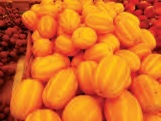 Ingredients: ½ pound hairy melon, peel 1. Prepare hairy melon, chicken, ginger, and garlic and
mix them with six cups of boiling water and the bouillon
cubes, hen reduce the heat and simmer for ten
minutes. 2. Now add the mushroom and carrot pieces and simmer for an additional hour, then add the doufu and both ground pepper. Simmer another fifteen minutes, then serve. |
 NUTS,
are edible fruits or seeds,
many true nuts, drupes, or dry
fleshy fruits surrounding a pit or a
stone, or a naked seed such as are pine nuts. Peanuts
are angiosperms not enclosed in a larger fruit or
another exterior part. The most popular nuts to the
Chinese are almonds, apricot seeds they consider nuts,
cashews, Chinese chestnuts, coconuts, ginkgo nuts,
peanuts, pine nuts, and walnuts. Also popular are
soybeans that some do call soy nuts; but these are not
nuts. Many nuts are popular for their oil and as
vegetables. They can be used dry or roasted, either
way in stir-fry dishes, in baked foods, as flavorings,
and/or when raw.
NUTS,
are edible fruits or seeds,
many true nuts, drupes, or dry
fleshy fruits surrounding a pit or a
stone, or a naked seed such as are pine nuts. Peanuts
are angiosperms not enclosed in a larger fruit or
another exterior part. The most popular nuts to the
Chinese are almonds, apricot seeds they consider nuts,
cashews, Chinese chestnuts, coconuts, ginkgo nuts,
peanuts, pine nuts, and walnuts. Also popular are
soybeans that some do call soy nuts; but these are not
nuts. Many nuts are popular for their oil and as
vegetables. They can be used dry or roasted, either
way in stir-fry dishes, in baked foods, as flavorings,
and/or when raw.
 Olives,
are fruits, though not
everyone thinks of them as such. To the
Chinese, the most important one in their
culinary is botanically known as Canarium album,
and called tol gai lan, huang lan, or bai lan. All
olives grow on evergreen trees, are often oval-shaped,
and have hard pits. This Chinese olive has very pointed
ends, many using them as tooth picks.
Olives,
are fruits, though not
everyone thinks of them as such. To the
Chinese, the most important one in their
culinary is botanically known as Canarium album,
and called tol gai lan, huang lan, or bai lan. All
olives grow on evergreen trees, are often oval-shaped,
and have hard pits. This Chinese olive has very pointed
ends, many using them as tooth picks.
Olives are astringent, and their pits or hard stones, when ground and consumed, TCM practitioners say can clear a fever, relieve poisoning from alcohol, benefit the throat by reducing chronic coughs, ease hangovers, slow down the bleeding of wounds, reduce chill blains, and reduce skin sore infections.
All olives are eaten processed, the Chinese bury many in salt after drying them in the sun for two or more days, then preserving them for weeks. The love them for their taste and for healing.
| Spicy Chicken with Chinese Olives |
|---|
2 pounds skinless and boneless chicken thighs ½ teaspoon salt 1/4 teaspoon ground white pepper 2 Tablespoons vegetable oil ½ cup unsalted roasted cashew nuts 1 teaspoon dried chili pepper flakes 1 Tablespoon honey 1 fresh hot pepper, seeded then slivered 1 sweet onion cut in large dice 10 Chinese olives, flesh cut away in large pieces. Pits discarded 2 Tablespoons oyster sauce 1 scallion, slivered on an angle Preparation: 1. Cut the chicken pieces into one-inch pieces and toss with salt and pepper. 2. Heat a wok, add the oil, and stir-fry the nuts for half minute, then remove them to a paper towel-lined bowl and discard the paper towel. Then toss them with the chili pepper flakes and add the honey and set aside. 3. Add the seasoned chicken to the wok, and stir-fry for three minutes, then add the onion pieces and stir-fry another two minutes before adding the olive pieces, and the oyster sauce. Return the chicken and onions and stir-fry for two minutes. 4. Add half the scallion pieces and stir for half a minute, then put in a pre-heated bowl and top with the rest of the scallion pieces, and serve. |
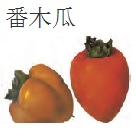 PAPAYA, also called paw paw, is
botanically known as Carica
papaya. It is a very large group of
tropical fruits growing on large
trees or their trunks. There are
some two dozen species, their fruits
technically are berries that are ripe
when soft and almost orange.
Female trees most often grow these fruits, one flower
left on to make for a stronger and larger fruit. These
fruits are very susceptible to disease and viruses, and
growers are working to genetically modify them.
PAPAYA, also called paw paw, is
botanically known as Carica
papaya. It is a very large group of
tropical fruits growing on large
trees or their trunks. There are
some two dozen species, their fruits
technically are berries that are ripe
when soft and almost orange.
Female trees most often grow these fruits, one flower
left on to make for a stronger and larger fruit. These
fruits are very susceptible to disease and viruses, and
growers are working to genetically modify them.
There are two main kinds of papayas, one with orange to red flesh, the other with yellow flesh. Either can be picked green and they usually are. Green papayas are used for salads and cold dishes, the orange-ish red ones eaten raw or cooked in soups or with meat or fish dishes.
| Papaya Soup with Fish |
|---|
1 two-pound green papaya, peel and seeds discarded, and cut into two-inch pieces 1 two-pound fish 3 ounces white Chinese wine 12 red dates, pits discarded, each cut in four pieces 6 slices fresh ginger, slivered 20 goji berries Preparation: 1. Remove skin and bones from the fish, and gut it. 2. Put pieces of the papaya and the fish in two quarts of water, then add the wine, dates, and ginger, and simmer for forty minutes. 3. Add the goji berries, and simmer for five minutes more, then serve hot or warm. |
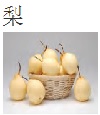 PEAR,
is a fruit that lovers
should not share. Why not,
because the Chinese word for
pear is identical to the word
meaning separation. That is
why Chinese friends do not like
to share a pear. This is true for
the common pear or the Asian
pear; the latter is crunchy and
tastes somewhere between a pineapple and a rose.
PEAR,
is a fruit that lovers
should not share. Why not,
because the Chinese word for
pear is identical to the word
meaning separation. That is
why Chinese friends do not like
to share a pear. This is true for
the common pear or the Asian
pear; the latter is crunchy and
tastes somewhere between a pineapple and a rose.
Most pears grow on deciduous trees, though there are two species growing on evergreen ones. Not all are pear-shaped, a few look like apples. One way to tell is when eating them. Some are ‘gritty’ in texture, apples never are. Pears are Pyrus, their species one of thirty or so. Some say there are a thousand pear species, others tell us there are many cultivars but only three species.
Pears grow their fruit on what is called the ‘spur’ which is a shoot more than a year old. Nashi or Asian pears look like apples but are more crisp. In Chinese, all pears are bai li. Chinese TCM practitioners tell us they moisten lungs, cool fevers, relieve the effects of alcohol, and ease constipation. Also, if one has a cough, diarrhea, or a cold feeling in the lungs, one should not eat any pear.
There is one pear called tang li in Chinese, in the species P. betulaefolia; It is round and sometimes known as a ‘false pear’ and it is used to stop diarrhea and ease acute throat irritations. One TCM doctor told us never eat these fruits without the skin, and chew them slowly for best results. He could not explain why, but did say to cook any type of pear any way you might like.

Copyright © 1994-2025 by ISACC, all rights reserved
Address
3 Jefferson Ferry Drive
S. Setauket NY 11720